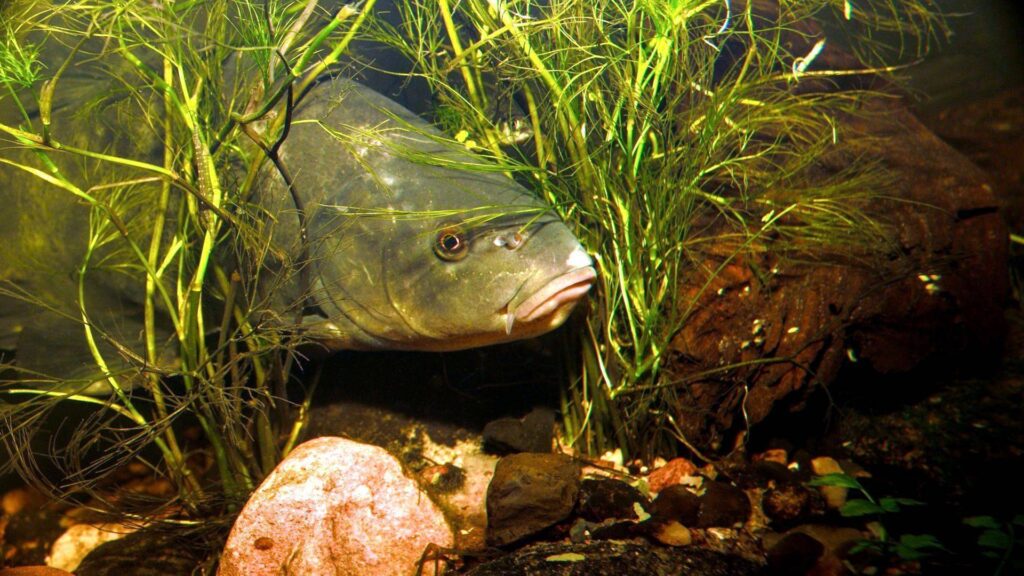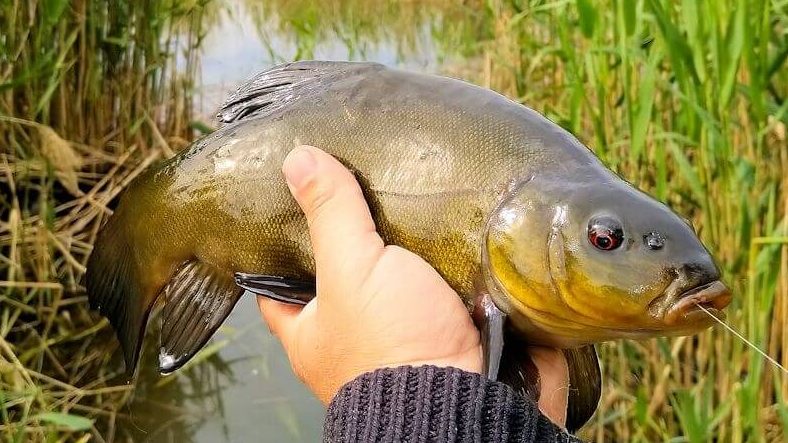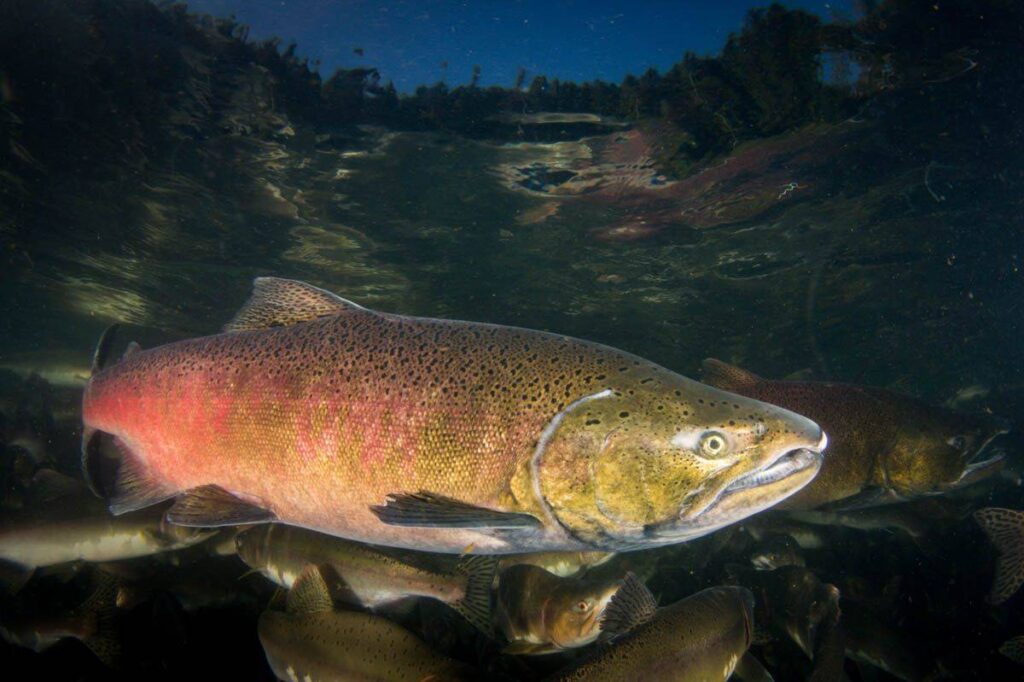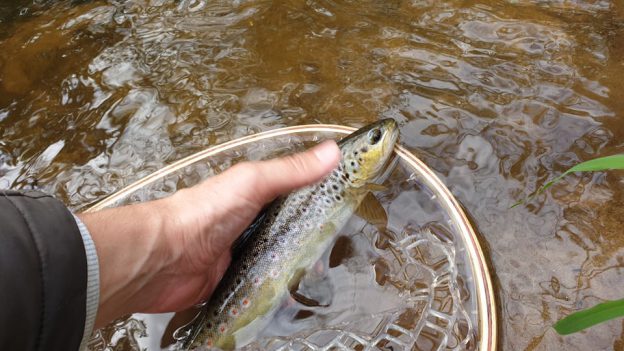The line is similar to the carp fish. The body color of the fish often changes shades depending on the body of water. The sandy lake has fish with a silver-olive and bronze hue. There are also dark green, almost black ones that live in heavily silted and peaty ponds. A distinctive feature of ropes is small bright red eyes, a small mouth with thick lips. The body is covered with small, slimy scales. Rope it is almost impossible to confuse it with other fish, because there are practically no similar fish.
Where the rope lives
Lynas is a fish that likes calm river bays covered with vegetation. Lynas feels comfortable in large ponds and lakes, lives on banks covered with reeds, lilies and grasses.
In the summer, ropes like shallow areas of water, well-heated by the sun in thickets with a muddy bottom, where the depth reaches up to 2-3 meters. They do not migrate around the body of water. They search for food by digging in the mud. You can understand that the rope has come to feed when many small bubbles start to rise to the surface of the water. This means that the rope is actively stirring the mud and looking for food.
Despite the fact that medium and large individuals live separately, young and small fish gather in small groups. With the approach of cold weather, autumn, ropes stop feeding, gather in flocks and, closer to the beginning of November, begin to hibernate.
INTERESTING FACT
Winter is considered a dangerous time for lines, because a sharp drop in the water level can kill fish, and in shallow water they can be crushed by ice. Linus is saved from the cold by the mucus on the scales - it is a kind of protective capsule.
The tench is a solitary fish that leads a sedentary lifestyle. Avoids bright light and hides in grass. Tendrils do not require high levels of oxygen in the water, so they can survive where other fish cannot.
Seasonal activity
The highest activity is observed in the morning and in the evening - usually during this period the rope will come closer to the shore. The fish spends the rest of its time in deep places, but continues to feed there. It is observed that on cloudy days, ropes can feed throughout the day.
In the spring and summer, the ropes live near the shores covered with vegetation, where there is a lot of silt at the bottom. Lives in places heated by the sun at a depth of 1-2 meters. Always lives in one place.
In autumn, with the arrival of cold weather, they stop feeding and hibernate in the mud pits of reservoirs and rivers. In winter, fish are not active - they hibernate.
Fishing takes place from spring to autumn. In the spring, when the water warms, the line moves closer to the shoreline, small areas of vegetation and algae, where they search for food.
What does the rope eat?
The basis of the diet of these fish is food of animal origin, although sometimes they can also consume plant food. Objects of hunting are invertebrates living in water and near water bodies: insects and their larvae, molluscs, crustaceans, worms. In the spring, they happily feed on algae and grasses.
INTERESTING FACT
Fish have no seasonality, they are completely unpretentious in terms of nutrition and eat everything they can find.
Snakes feed on bottoms with peaty or silty soil and in thickets of underwater plants. These fish have to dig the bottom to get food. In the fall, the ropes feed less than in the summer, and during the winter they do not feed at all.
But come spring, when it becomes warm, the ropes wake up from hibernation and migrate closer to the coast in search of nutritious food. They feed on fish and mosquito larvae.
Reproduction
Tench is considered a thermophilic fish that can spawn quite late, usually in late spring or early summer. As a spawning ground, they usually choose a shallow place protected from the wind and richly covered with aquatic vegetation. They lay their eggs at a depth of 30-80 centimeters and are often attached to the branches of bushes or trees that are lowered into the water growing near the shore.
Spawning occurs several times with an interval of 10-14 days. Fish that have reached puberty, 3-4 years old, participate in the spawning process. Only those fish whose weight reaches at least 200-400 grams reproduce. In one season, fish can lay about 20-500 thousand eggs, which mature in three days.
The size of the fry does not exceed 3.5 millimeters, it remains in the same place where it was born. All this time, the larva is growing rapidly, feeding on the reserves left in the yolk sac.
Once the fry become independent, they gather in flocks and hide in dense underwater vegetation, eating animal plankton and single-celled algae to survive. Later, when the fish reaches a length of about 1.5 centimeters, the fry travel to the bottom, where they begin to feed on more nutritious food.
Fishing
Lines are picky about baits. For this reason, catching ropes can seem like a rather complicated process. However fishing becomes an interesting process if you know about the habits of fish in a particular lake.
Summer
Summer is the best time for line fishing. Fish are more active during this period. Depending on the nature of the fish food, it is caught on several types of gear - floating and bottom fishing rods. The first method is good because it shows excellent catching results. As for the bottom rod, it is better to give preference to the method feeder, because it catches in muddy places and ordinary feeders will simply follow the mud. You can read about method feeder fishing in my article.
At the beginning of the open water season, ropes feed on animal food, so earthworms, nightworms, and worms are used as bait. Lin likes the leeches that live in the pond. A little later, when the plants appear, the fish's menu becomes diverse and you can start using a variety of boilies, corn, etc.
The best fishing plant baits begin at the end of summer. Fishermen use barley, peas, corn. Fish are indifferent to cottage cheese. Some anglers find that adding cottage cheese to some lures improves the hooking significantly.
Winter
Although roe are not very active in winter, in some waters with good oxygenation and warmer water, roe may come out of hibernation and start feeding. This rarely happens. If the rope gets caught on the hook in winter, it is considered simply a great success.
Rope making
There are several nuances that will help you choose a fresh one fish for frying. After all, fresh rope can be stored for no longer than 3 days, and it must be gutted before storage. Cooked fish is stored much longer, at a temperature no higher than +5 degrees. But still, first of all, you need to buy it in the market or store or catch it with your own hands. If you caught the line yourself, there will be no problems with the freshness of the fish. If you want to buy it, you need to examine it carefully.
- The eyes of the fish should appear transparent.
- Press the fish with your fingers. If a dent remains after that, the fish is not fresh.
It is also worth paying attention to the useful properties of the rope. 100 grams of meat of this fish contains only 40 kcal, so it is irreplaceable as a dietary product. Meat contains many useful components, such as vitamins, minerals, high-quality proteins. Due to the high-quality protein containing essential amino acids, doctors recommend eating this fish regularly.








